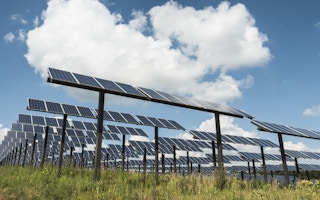We are well on track to see the climate heat up by 6°C. This would be disastrous for humans, the environment and the global economy. To avoid this scenario, significant investments in low-carbon technologies and projects are needed. But where should the cash come from?
Many governments, particularly in the West, are already struggling against a huge debt burden. Meanwhile, institutional investors globally are putting up a meagre 0.001 per cent of their $70 trillion investment pool towards climate finance.
Will “green” bonds be the saving grace?
A green bond, like a regular bond, accesses financial markets to raise capital. However, the proceeds of a green bond are dedicated to specifically finance “green” initiatives, such as renewable energy or energy efficiency. The World Bank issued the first green bond in 2008, raising funds from fixed-income investors to support World Bank lending for eligible projects that seek to mitigate climate change or help affected people adapt to it.
Since then, the green bond market has experienced significant growth, particularly over the past two years. According to figures from the Climate Bonds Initiative and HSBC, in the first half of 2014 alone, over $35 billion green bonds were issued, representing year-on-year growth of over 60 per cent. The investment potential for green bonds in the climate space is estimated to be worth over $500 billion.
“
As long as the green bonds concept was in a pilot phase, getting the industry excited without asking too many questions was good enough. However, at the current growth speed, green bonds must prove that they do indeed contribute to solving pressing environmental issues.
In addition to multilateral institutions, private issuers such as Unliever, Toyota and GDF Suez have entered the scene. Remarkably, although the bulk of green bonds are issued in Europe, Asian investors have been taking a stronger interest of late. For example, Taiwanese corporations ASE and Neo Solar both issued green Bbnds in July 2014.
The big challenge that comes with this impressive growth story is the question of quality and transparency. Key issues to safeguard the credibility of green bonds include:
- Impact: How can the issuer demonstrate and, if possible, quantify the positive impact of the green bond, and how can an investor measure impact consistently across portfolios?
- Additionality: How can the issuer ensure that the proceeds are indeed used for the declared “green” purpose and that the new green bond is not just a rebranded normal bond that would have been issued anyway?
- Verification: Is there any third party monitoring and verifying that the purpose of the green bond has been met?
As long as the green bonds concept was in a pilot phase, getting the industry excited without asking too many questions was good enough. However, at the current growth speed, green bonds must prove that they do indeed contribute to solving pressing environmental issues.
The industry thus needs to move very fast and agree on simple, but robust standards to address the issues mentioned above. Initiatives like the Green Bonds Principles, the Climate Bonds Standard or the CICERO Second Opinions on Green Bond Investment Frameworks are great contributions to achieve this goal. And, the UN climate convention’s approach of setting standardized baselines could provide meaningful input.
Green bonds have the potential to emerge as the number one instrument to finance environmental technology and projects. Or, to enter the history books as a failed exercise to paint business as usual financial streams in a bright green colour.
Renat Heuberger is the chief executive officer of South Pole Group and is a Schwab Foundation social entrepreneur. This post originally appeared on the World Economic Forum blog.











